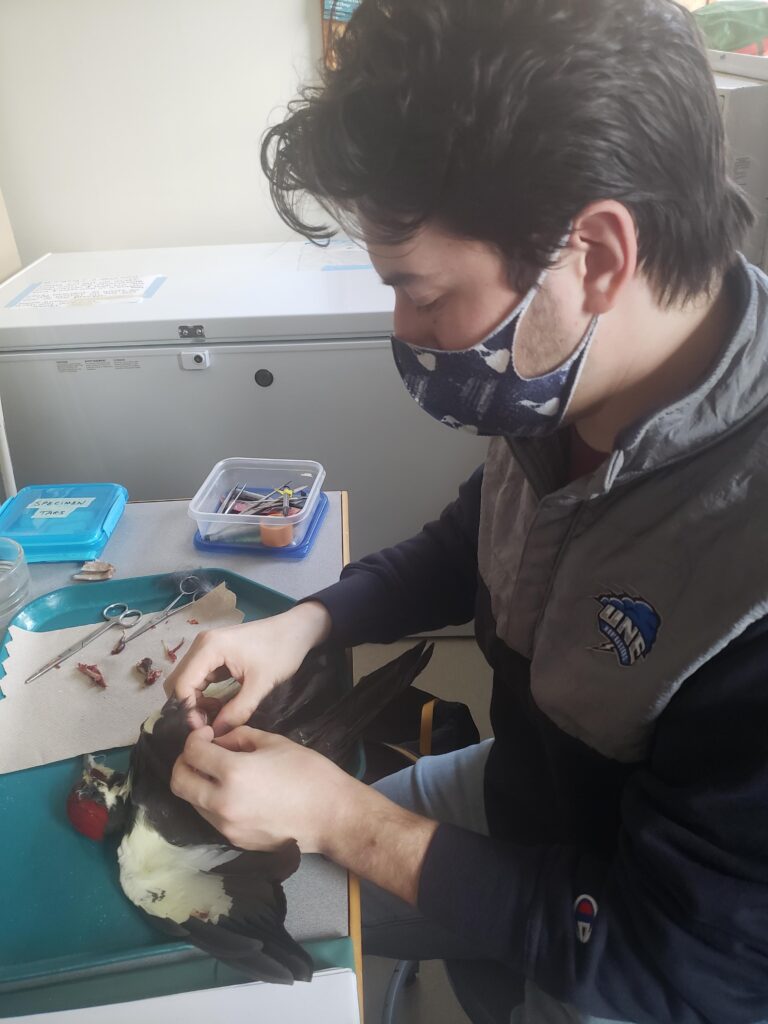Sam Fuller, Environmental Studies 2022’

In late fall 2018, my freshman year, I met with my new advisor, Dr. Richard Peterson. I had just switched majors from aquaculture to environmental studies, and was in the process of selecting classes for the following spring. He knew my interest in birds and suggested I take ENV 319: Museum Specimen Preparation. Giving it little thought, as it was only a one credit class, I agreed and registered for it a few weeks later. I cannot overstate how much impact that one credit class had on me. Preparing specimens brings me a lot of joy and is a great way for me to take my mind off things. It has been one of my best college experiences and will be something I hope to continue in the future.
I remember walking into the classroom not knowing what to expect. There were bags of dead birds sitting on the counter, ready to be selected and subsequently cut open. The first bird I prepared was a Dark-eyed Junco. Having done nothing like this before, it provided a serious challenge. When I finally finished the Junco over the course of a few classes, I was mentally exhausted and somewhat frustrated. At first, I resented the class; having to spend three hours in a lab struggling to mutilate a poor dead bird was not my idea of a good time. I continued to struggle and became increasingly frustrated with how my specimens were turning out, but eventually, I got the hang of it. I started asking more questions and gained a better understanding of the process. Most importantly, I gained a better appreciation for the bird itself. My final bird of that first semester was a Common Loon. That bird provided a unique challenge, as it was larger than any bird I had worked on before. With some help from my teacher, Emma White, and at times a saw and hammer, I finished the Loon in about 14 hours. A lot of birder’s claim to have a “spark bird,” a bird that they saw that got them into birding; the Common Loon was my spark bird for preparing specimens. From that term on, I have continued preparing specimens for my on campus (work study) job.
My favorite part of working on birds is the little details of each bird. It is cool to see the unique attributes of each species or group of birds. By carefully studying each individual, I can get a better understanding of how the bird lived, or how the bird died. One of my favorite things is to see what the bird had eaten right before it died. I have worked with Cedar Waxwings with berries in their crop and stomach, Loons with crustacean shells, Owls with rodent bones, and Cuckoos with whole worms. I also enjoy observing the little details that you can only notice up close, like the little brown birds that most people look past. When you get to see one right in front of you, you notice all the different shades of brown that make that bird unique.
While there is so much of this work that I enjoy, there are definitely things that I struggle with. Preparing a specimen requires a lot of patience, and sometimes that patience can get tested. Sometimes the bird just isn’t doing what you want it to. My biggest challenge is working with smaller birds. I think that I have come so far until I attempt a really small bird like a Ruby-crowned Kinglet, and am reminded that there is still plenty for me to learn and practice. Another challenge that comes with this work is how mentally exhausting it can be. The amount of focus that is required can be quite taxing. My friend Xander decided to take the class this semester, and when he finally finished his first bird, he said to me, “I never realized how tiring this would be, my eyes are so tired”. Even with these challenges, the work is worth it.
I want to mention something that I always remind myself while working. Even though it is really cool to see these birds up close and I am grateful I get to do this for a job, it is a somber reminder that each bird died. Window strikes, which is what killed most of the birds in our collection, is the number one killer of birds. So even though I have a unique experience in turning them into museum specimens, most of the birds I work on were killed because of human buildings. Approaching my sixtieth completed specimen, I always keep in mind to respect each bird, and to give it the best care possible.
